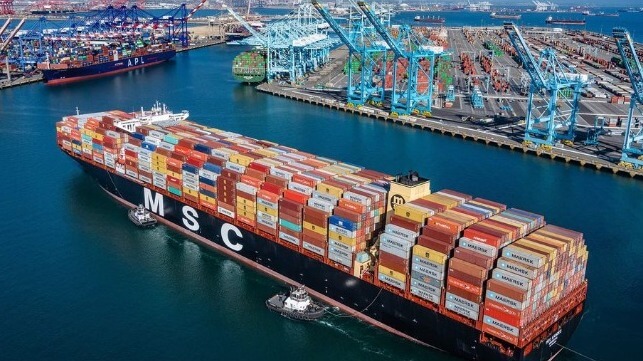Imports Surge Continues at U.S. Ports Ahead of Lunar New Year

While there has been speculation that the worst of the supply chain disruptions might be over, port officials report that the surge in imports shows little signs of letting up after the year-end holidays and as the new year begins. While some ports such as Savannah continue to predict success in clearing the backlog of container ships, the number of vessels heading to the Southern California ports shows no signs of abating.
“We are in a mini-peak ahead of the lunar New Year,” Port of Los Angeles Executive Director Gene Seroka told CNBC during a January 4 interview on the Squawk Box program. “The caravan of cargo continues.”
The Marine Exchange of Southern California’s first reports for the new year confirms that little progress has been made in reducing the backlog. However, the new vessel reservation system has been successful in spacing the ships out removing the images of the containerships stacked up in the anchorage offshore. The report shows that there are just 16 vessels either in the anchorage or within the 40-mile radius outside the ports of Los Angeles and Long Beach. The total, however, remains largely unchanged with an additional 89 vessels having registered for arrival slots and slow steaming their way toward Southern California. A total of 105 containerships are heading for the terminals in the twin ports, but demonstrating the efficiency of the new queuing system, of the 17 containerships arriving over the current three-day period all but one is going directly to the terminals.
Seroka in his interview told CNBC listeners that there is additional capacity both in the rail lines and unused truck reservation slots. He said the goal is to use every element of capacity and squeeze every hour and shift capacity to maximize efficiency.
IHS Markit’s analysis of the data reports, however, reports that productivity in the ports has fallen with dwell times rising. They told the Journal of Commerce that there is “a dramatic increase in average berth hours” citing that the crowded yards and terminals make it more difficult to offload the containers.
Empties continue to be one of the largest problems says Seroka. On CNBC he cited data that 71,000 empties were sitting at the terminals as of the beginning of this week with an additional 10,000 TEU in the off-dock yards that had been set up to relieve some of the pressure at the terminals. He said more than two-thirds of the boxes have a dwell time of nine days or greater, leading to the ports’ newly proposed fee to encourage carriers to clear out empties and return them to Asia.
“It’s hard to tell if the supply chain pressures are peak – have peaked,” responded John Porcari, Port Envoy to the White House Supply Chain Task Force during a media briefing on January 5. “I think what is clear is the pandemic laid bare what was the underlying reality, which was the supply chain was stressed even before the pandemic. And we clearly have changes to make to build a more durable, resilient supply chain.”
Asked what he sees going forward, Seroka told CNN in an interview, “I don’t see us falling off a cliff.” He expects that consumers spending will remain strong fueling the volumes of imports into 2022. He, however, believes that large retailers, in particular, are getting more strategic in their shipments and that is both helping smaller shippers to find capacity and reducing the overall challenges going forward for the ports.
"The system was gummed up because a lot of people on the larger side had gone from just 'in- time' inventory management, to 'just in case',” Seroka told CNN. “They wanted to get their orders into factories before their competitors did, they didn't want to be the 'paper goods person of 2021'."

that matters most
Get the latest maritime news delivered to your inbox daily.
The Port of Los Angeles expects that when the final tally for 2021 is completed, that it will report a 13 percent increase in container volumes to a record 10.7 million TEU. Seroka forecasts that the current rush to get goods onto the ships will continue up to the Lunar New Year holidays meaning that it will continue to arrive at the port till late February before the pressures decline with the Chinese factories expected to be closed for the holiday.
